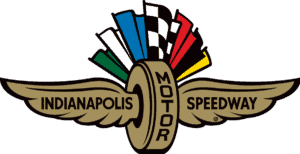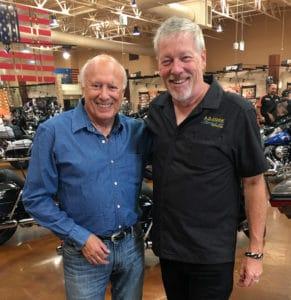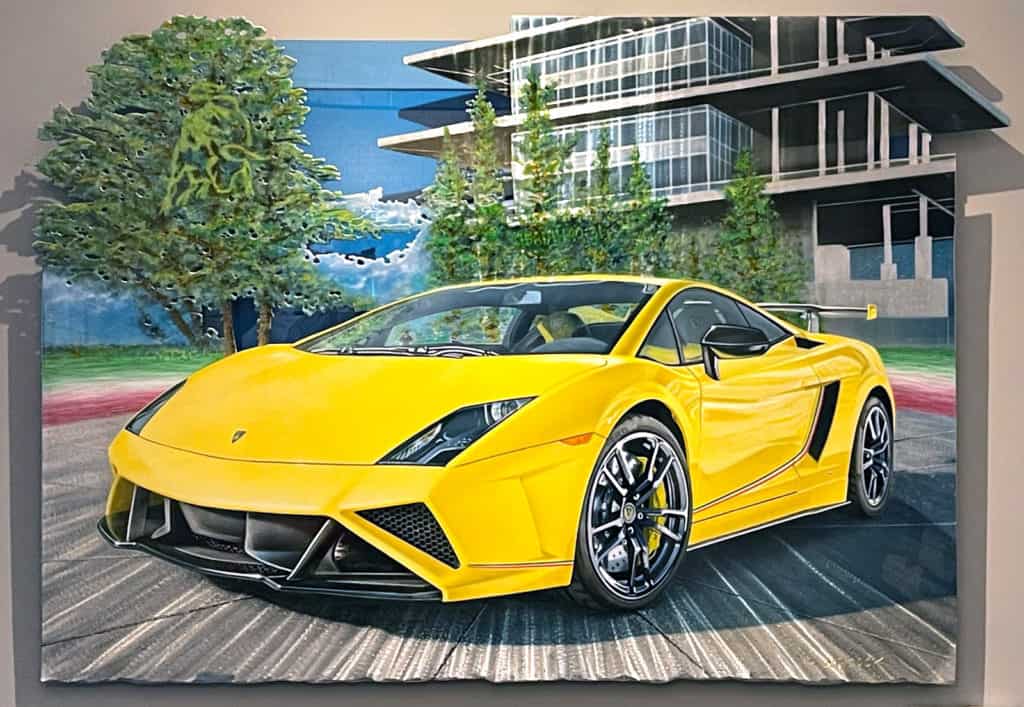
Brickyard Bull, 40” x 60”, urethane on hand-ground metal, 2021
A Lamborghini Gallardo Squadra Corse Painted in Pearls
My latest creation is titled BRICKYARD BULL. At a glance, this artwork is a colorful car portrait of a very special 2014 Lamborghini Gallardo Squadra Corse LP-570, one of only fifty in the world and one of only fifteen in the United States.
But there’s more to it than that. This new artwork has a fantastic story and miles of provenance, even before I finished the painting.
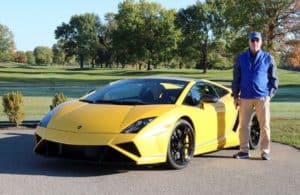 This commissioned original metal artwork started like most of my other realism paintings with a photoshoot. I flew to Indianapolis, Indiana, to visit my collectors and photograph their fantastic car for this painting.
This commissioned original metal artwork started like most of my other realism paintings with a photoshoot. I flew to Indianapolis, Indiana, to visit my collectors and photograph their fantastic car for this painting.
After enjoying a much-need morning coffee with my collector, Mark, we embraced the morning cold and headed out to see his new car. Compared to Las Vegas, it was a bit colder than I was used to, but it was a perfect morning for an outdoor car shoot. The sky was a beautiful crisp blue and clear except for a few soft clouds lightly scattered overhead.
I started by taking a few pics at the Brickyard Crossing Golf Course, which looked great with the pearl yellow supercar set against the green grass lightly frosted with the morning’s dew.
Next, we found ourselves at the famous Indianapolis Motor Speedway, first photographing near the outer perimeter of the track before finally relocating to the Pagoda in the center of the world-famous Brickyard.
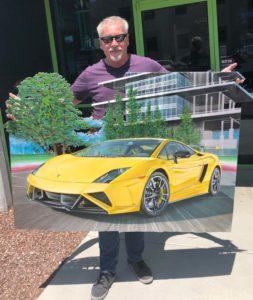 When I started the painting, I didn’t fully connect the dots that the Indianapolis Motor Speedway was known as the Brickyard. I’ve heard it called that but never made the connection to why. The backstory is fascinating and is a huge part of racing history. It turns out that it was made from crushed stone and tar back in nineteen-oh-nine when the IMS track first opened. That sounds nasty. And it was. I imagine it was like one giant sheet of sticky sandpaper. As you might expect, a lot of drivers got hurt. Some got hurt bad, and some died. Finally, the speedway resolved to fix their track’s surface by resurfacing it in millions of bricks, so the speedway became known as the Brickyard.
When I started the painting, I didn’t fully connect the dots that the Indianapolis Motor Speedway was known as the Brickyard. I’ve heard it called that but never made the connection to why. The backstory is fascinating and is a huge part of racing history. It turns out that it was made from crushed stone and tar back in nineteen-oh-nine when the IMS track first opened. That sounds nasty. And it was. I imagine it was like one giant sheet of sticky sandpaper. As you might expect, a lot of drivers got hurt. Some got hurt bad, and some died. Finally, the speedway resolved to fix their track’s surface by resurfacing it in millions of bricks, so the speedway became known as the Brickyard.
I love these backstories because I like to include them in the artwork somehow. In this case, the Brickyard story inspired the artwork’s title. And, as you might expect, the Bull part of the title is the Lamborghini. But together, the title honors the car’s owner, the real brickyard bull. Look close, through the windshield, and you’ll find him there, the man behind the bull.
Above, another bull, the Lamborghini icon, is nestled within the large tree branches and leaves, keeping watch over the Bogota and the ultra-rare Gallardo.
The term “Brickyard” is a reference to the nickname historically used for the Indianapolis Motor Speedway. When the race course opened in August 1909, the track surface was crushed stone and tar. That poor surface was the cause of numerous and sometimes fatal accidents, so the track was subsequently repaved with 3.2 million bricks. Over time the bricks were paved over with asphalt, and now only a boneyard strip of bricks at the start/finish line remains exposed.
Wikipedia
Of course, the painting wasn’t officially the Brickyard Bull until it was finished, or close to finished, anyway. Before that could happen, I had to get started. After wrapping up our photoshoot and returning home to Las Vegas, I was particularly excited to begin this artwork. While I have driven many Lamborghini supercars, I hadn’t yet painted one. The opposite was true for my previous Ferrari painting, Fast Forward.
While at the Brickyard, I shot dozens of pics. Now, back in Las Vegas, sitting at my computer and staring at my monitor, I went through them all, one by one, in search of the perfect reference shots.
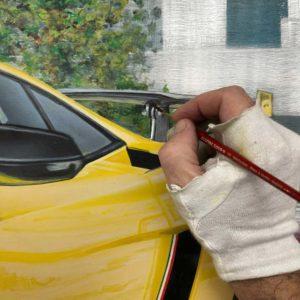 My collectors graciously allowed me to create pretty much whatever I wanted, so long as it included his car. So, at this point, neither of us knew where this project would take us. I just knew at that point, I wanted it to be special.
My collectors graciously allowed me to create pretty much whatever I wanted, so long as it included his car. So, at this point, neither of us knew where this project would take us. I just knew at that point, I wanted it to be special.
I am grateful for collectors who trust me to fully create. As a concept-to-completion artist, my best work comes, I believe, from my involvement from the early phase through the finished work, especially when it comes to original artworks. And the free rein to create as my heart and mind’s eye leads me is a treat. In the end, I believe many of those pieces represent my best work, mostly because of the trust and my respect for the collector, know that this will be forever special to them.
Back to the project at hand. After hours of scrolling through the shots from my INDY trip and taking notes of my favorites, I narrowed my choices down to a few, then to a couple of favorites, before finally deciding on the one that I was going to use as my master reference image.
 Brickyard Bull finished painting detail
Brickyard Bull finished painting detail
Then, as I often like to say, “All that’s left is everything.” While I often draw up a quick mind map and a checklist for these kinds of artworks, I also like to stay open to happy accidents and inspired moments. Often, the best ideas happen as the project develops, as is the case with this piece.
My Creative Process
As I take inventory of what it takes for me to complete an original artwork, like the metal Lamborghini portrait, I reflect back on all that I’ve learned and the various processes that come into play to create this painting;
- Reference Photos: Before I could begin my artwork, I flew to Indianapolis and did a photoshoot with the car, a rare twenty-fourteen Lamborghini Gallardo Squadra Corse, essentially a street-legal version of the Gallardo LP 570-4 Super Trofeo race car.
As my collector drove his beautiful beast to the Indianapolis Motor Speedway, my head was already swimming with ideas. I have been a massive fan of Lamborghini and had driven plenty of them through my friendship with Tom, but this would be the first time to create a painting of one.
When we arrived at the speedway, my collector was granted permission to park his Midas yellow beast at the Indianapolis Motor Speedway Pogoda control tower, located in the center of the raceway.
The Pagoda is one of the most recognizable structures at the Indianapolis Motor Speedway and in worldwide motorsports.
- Design: After returning to Las Vegas, I printed a few of my favorite shots and pinned them to my wall for consideration. Next, I took scissors, knives, and markers to comp up some ideas.
- Metal Prep: Starting with a fresh 48” x 60” sheet of aluminum and a power grinder, I began the process of grinding my metal. As is with all my metal pieces, the grinds in this painting are designed to complement the artwork, so there are vertical grinds for the building and organic grinds for the trees. In addition, the asphalt ground beneath the car includes metal grinds that race forward from a common vanishing point. These grinds give the finished artwork a holographic effect and the added sizzle that I love about metal art.
Next, I used a power scroll saw to cut out the shape for the upper half of the painting around the trees and building. The sides are smooth and the bottom edge of the artwork is organic. Other metalwork details include drilled and shaped holes within the trees and building.
The grinding process took about five days to complete. Once I was happy with the metal, I prepped it with a chemical bath so it was finally ready for paint.
Easel Time: With my metal prepped for paint, some would say that it’s was a cool piece as it was, but that is just the beginning.
Working back to front, I hand-scribed and painted the building and trees. With exception of the car, everything is painted in transparent colors so that the metal’s grind-work shows through.
When I was happy with the background, I carefully masked off the car, and using a small spray gun I applied multiple layers of opaque white urethane base coat before wet-sanding it to a smooth finish, eliminating any visual grinds.
Over the white, I sprayed a solid base of opaque Lamborghini Giallo Midas yellow, covered in pearl, which is the exact OEM color for the car. Finally, I tackling the car’s details with airbrushes and small paintbrushes as needed.
Clearing the Painting: Finally, the completed artwork is cleared with multiple coats of automotive urethane in a body shop spray booth, where it is then polished and buffed to a glass smooth finish.
Plus: Finally seeing the proverbial light at the end of the tunnel, I had a sheet of 1/4” transparent sky blue acrylic cut to size. Some custom trimming of the acrylic created a nice organic edge tailored to the artwork.
Frame Support: This painting, as is with most of my metal artworks, is supported by a hidden metal frame mounted to the back of the artwork so that it has the illusion of floating a couple of inches in front of the wall. A z-bar is mounted to the back of the frame to ensure that the artwork always displays securely and is forever level.
Delivery and Unveiling: One of my greatest pleasures in creating art is delivering my creations to their new owner. That means the next step is to safely transport my new metal masterpiece two thousand miles, from Las Vegas to her new home in Indianapolis.
Indianapolis Motor Speedway logo is a registered trademark of IMS LLC
- About the Author
- Latest Posts
- More info
A.D. is an artist who started drawing at a young age. Throughout his life, he has worked with different creative tools in traditional and digital art and design. His art and writings have been showcased in various publications such as Airbrush Action Magazine, Airbrush Magazine, American Art Collector, Art & Beyond, Dream To Launch, Easyriders, Las Vegas City Life, Las Vegas Weekly, L’Vegue, ModelsMania, Quick Throttle, and The Ultimate Airbrush Handbook.

